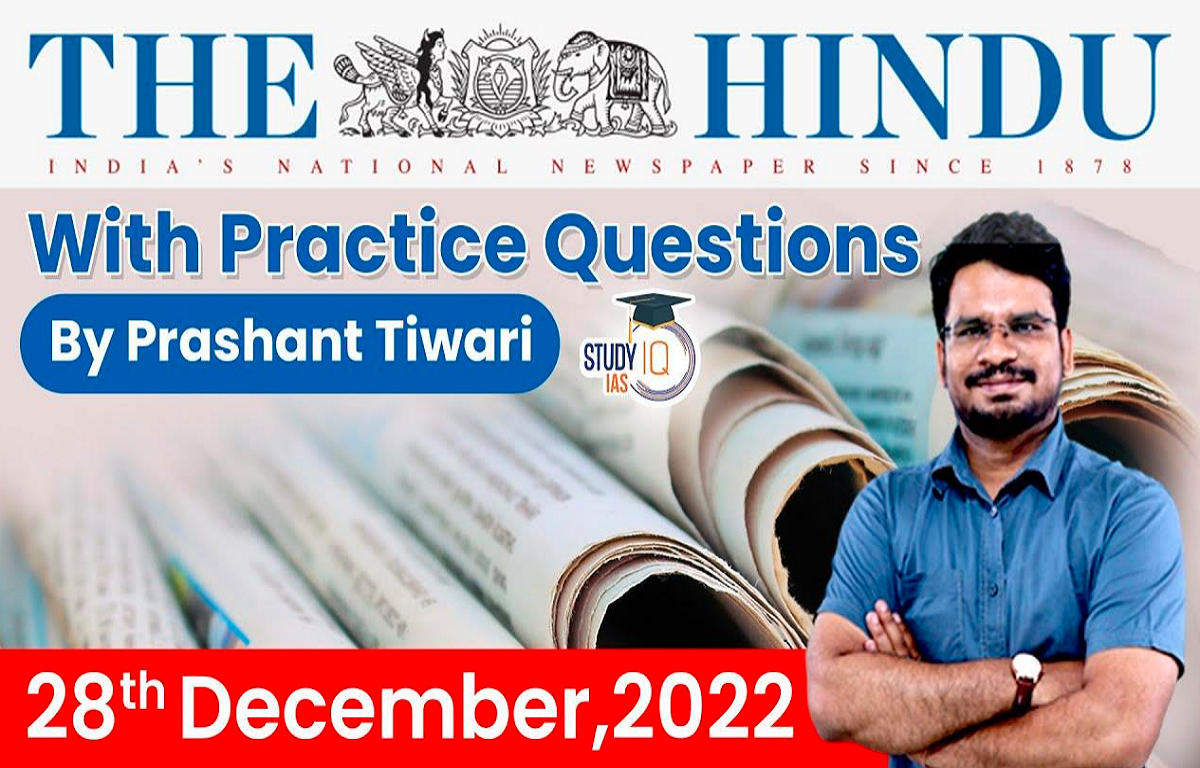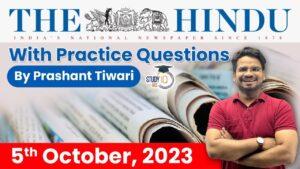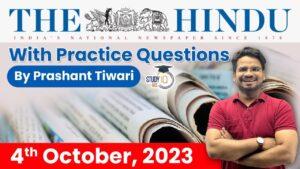The Hindu Newspaper Analysis for UPSC

The Hindu Newspaper Analysis 27 December 2022
- The exercise checked the availability of hospital beds, oxygen, ventilator support, following a directive from the Centre; India reported fewer than 200 COVID-19 cases on Tuesday
- A global surge in coronavirus cases, particularly in China, prompted authorities to assess India’s preparedness. The country, in keeping with trends from the past two weeks, reported fewer than 200 cases on Tuesday, with no confirmed reports of novel infectious variants.

- In the absence of reliable data on the toll on human health and life, rough approximations indicate millions of people with symptomatic diseases and adverse outcomes in China.
- There were two principal approaches; the first was promoting herd immunity by allowing the virus to infect everyone, which also advocated focused protection of the people at risk. The biggest problem with this approach was that it resulted in many deaths among the elderly and the others who were vulnerable.
- The second was to follow the other extreme, known as the Zero-COVID strategy of not allowing even a single case of COVID-19 by imposing strict lockdowns, closing borders, and imposing travel bans. As the vaccination rates (with effective vaccines) increased significantly, countries that followed the strategy abandoned it mid-course as it was untenable. These countries scaled up vaccine production, leveraged vaccination delivery, and urged the public to adhere to COVID-appropriate behaviour.
- China followed the unrealistic and prolonged Zero-COVID strategy as a lofty goal, as if the virus was destined to disappear on its own. While the virus was emerging in different forms with varying infectiousness and virulence, China stuck to the same policy. The Zero-COVID strategy rendered the Chinese population relatively more vulnerable to the virus without better vaccines and strengthened health systems.
- Given the understanding that only Omicron and its sub-lineages are circulating in China, it is very unlikely that these can result in large waves of infection or fatality in India. This assertion arises from hybrid immunity, offered by both the high burden of Omicron, and greater vaccine coverage with primary doses.
- The possibility of a newer variant emerging out of the high-circulation ecosystem in China is a real concern. The primary requirement for understanding this will be based on the data made available by China in terms of epidemiological data, clinical features, mortality, and genomic sequencing.
- Integrating and unifying the efforts to balance and optimise the health of people, animals, and the environment is called “One-health”.

- This year, International Migrants Day (observed annually on December 18) must be seen in the backdrop of unprecedented volatility that began in 2020 as a result of the COVID-19 pandemic. Besides this infectious disease outbreak, there were events such as the Taliban takeover of Afghanistan, Russia’s invasion of Ukraine, worsening poverty in the sub-Saharan region, and also climate change, resulting in large-scale migration.
- According to the International Organization of Migration (IOM)’s World Migration Report 2022, there were 281 million international migrants globally in 2020, with nearly two-thirds being labour migrants. While there were 169 million labour migrants in 2019, the figure touched 164 million in 2020.
- In the larger pool of migrants, South Asia’s share is nearly 40%; further, the South Asia-Gulf Migratory corridor is the world’s largest migrant corridor.
- Long-term data on international migration show that “migration is not uniform across the world and is shaped by economic, geographic, demographic and other factors, resulting in distinct migration patterns, such as migration corridors developed over many years”.
- Unfortunately, despite India being the largest migrant-sending and remittance-receiving country, the welfare of Indian migrants abroad is hardly a priority for the Government and policymakers. It is a matter of serious concern that India has yet to have a tangible and comprehensive migration policy to ensure decent living and safe movement of migrants.
- India manages or governs Indians migrating abroad using the Emigration Act, 1983. In the last 40 years, migration has witnessed sea changes. However, the Indian government has been silent on the issue of updating the Act.
- The kafala system in Saudi Arabia previously tied workers to their employers, or sponsors, who are responsible for the employees’ visa and legal status.

- India, through the G20 presidency, intends to be remembered as the voice of the Global South at the heart of which is Africa. Most of the 54 countries of this continent are developing or least developed countries. To truly represent the South, it is essential to grasp the mood and changes in Africa, especially in its external partnerships.
- Nevertheless, the U.S.’s attempts to raise its profile in Africa remain episodic and faulting. China, on the other hand, has emerged as the largest trading partner and the fourth largest investor in the African continent, ahead of the U.S., through its steady diplomacy and extensive economic engagement.
- India’s equity in Africa is older and richer than that of China and the U.S., but that should not be a source of complacency.

- Merely drafting a National Tourism Policy is not enough for the development of the tourism sector in the country, a parliamentary committee has said.
- The Parliamentary Standing Committee on Transport, Tourism and Culture has suggested fast-tracking the creation of a National Tourism Council on the lines of the GST Council to directly make recommendations to the Union and the State governments.
- Observing that “Vision without action is a daydream, and action without a vision is a nightmare”, the panel sought to know from the government the action taken for the creation of the Tourism Council after the inter-ministerial consultations.
- The committee also sought to know the steps taken by the Tourism Ministry regarding its earlier recommendation of including tourism on the Concurrent List.

- The government has announced that it will roll out vaccines for the prevention of cervical cancer to girls aged between 9 and 14 years through schools. The National Technical Advisory Group for Immunisation (NTAGI) had recommended the introduction of the Human Papillomavirus (HPV) vaccine in the Universal Immunisation Programme (UIP). The UIP is one of the largest public health programmes which offers free vaccines for at least 12 diseases, and has successfully eradicated diseases like polio and maternal and neonatal tetanus.
- Cervical cancer is preventable and curable if it is detected early and managed effectively. It is the second most common cancer in women in India, and the cause of a large number of deaths annually.
- According to the paper, globally, there were an estimated 6,04,127 cervical cancer cases in 2020, with an incidence rate of 13.3 new cases per 1,00,000 women a year. In India, the incidence rate is 18 per 1,00,000 women. The WHO has specified that countries must maintain an incidence rate of fewer than 4 new cases per 1,00,000 women a year by 2030.
- The indigenous HPV vaccine, called CERVAVAC, is likely to be rolled out by mid-2023. The vaccine has got the approval of the Drugs Controller General of India and was cleared by the government advisory panel, NTAGI, for use in the UIP programme.
- The government has clarified that girls who do not attend schools will be given the vaccines by community outreach and mobile health teams. Together with vaccination, screening programmes need to be conducted regularly to detect early signs of the disease that will allow time for treatment.
- According to The Lancet study, the burden of cervical cancer remains high in Asia and Africa. The study identified substantial geographical and socioeconomic inequalities in cervical cancer globally, with a clear gradient of increasing rates for countries with lower levels of human development. In 2022, India ranked 132 out of 191 countries on the Human Development Index.

- At its core, the NRC is an official record of those who are legal Indian citizens. The NRC was born out of independent India’s first census in 1951, entailing the transfer of data from the Census slips.
- It includes demographic information about all those individuals who qualify as citizens of India as per the Citizenship Act, 1955.
- All States were mandated to compile an NRC but it was done only in Assam.
- Manipur and Tripura were also granted permission to create their own NRCs, but it never materialised
- The intention behind carrying out such an exercise in Assam was to prepare a village-based inventory of residents in view of the resistance from the State — then undivided — to house post-Partition refugees.
- Assam saw waves of migration, first as a colonial province and then as a border state in independent India
- The first National Register of Citizens was compiled in 1951, after the Census was completed that year. This NRC was prepared under a directive from the Ministry of Home Affairs (MHA).
- The NRC list of Assam comprised of those who lived in India on January 26, 1950, or were born in India or had parents who were born in India or had been living in India for at least five years before the January 26, 1950 cut-off.
- An NRC was first created in 1951 in Assam to identify those born in India and migrants from erstwhile East Pakistan, now Bangladesh.
- In 2013, the Supreme Court issued directions to the Centre and State to initiate an exercise in Assam to update the 1951 register. The order was based on a petition filed by an NGO named Assam Public Works. The first draft was released in 2018.
- The final list, published in 2019, included those who could establish their Indian citizenship by being residents or descendants of people living in Assam before March 25, 1971 — the cut-off date for deportation of foreigners as per the Assam Accord of August 1985.
- As many as 19.06 lakh people out of 3.3 crore applicants were excluded due to a lack of adequate documents to prove their citizenship.
- At the time, the process to update the NRC was started in December 2014 with a deadline for completion in February 2015 and the project cost was pegged at ₹288.18 crore. There was, however, a five-fold increase in the cost by March 2022 due to additional time to complete it and changes in the update software. “The final draft of the document was, however, published in August 2019 and the project cost escalated to Rs 1,602.66 crore (expenditure of Rs 1,579.78 crore was reported),” mentioned the report. It said that a test check of records revealed irregularities in the utilisation of funds including “excess and inadmissible payment to vendors”.
- As for irregularities, the CAG found that the amount of wages paid to the outsourced staff was 45.59%-64.27% less than what was approved by the NRC coordination committee. It was this difference in wages that allowed the undue benefit of ₹155.83 crore to the system integrator beyond the 10% “reasonable profit margin”, the CAG said. Information technology firm Wipro Limited was entrusted with one of the prime software installation companies by the NRC Directorate.
Q) Consider the following statements regarding Pradhan Mantri Poshan Shakti Nirman (PM POSHAN).
- The scheme provides one hot cooked meal in Government and Government aided Schools.
- The Scheme is being implemented by the Ministry of Women and Child Development.
Which of the above statements is/are correct?
- 1 only
- 2 only
- Both 1 and 2
- Neither 1 nor 2
प्रधानमंत्री पोषण शक्ति निर्माण (पीएम पोषण) के संबंध में निम्नलिखित कथनों पर विचार करें।
- यह योजना सरकारी और सरकारी सहायता प्राप्त स्कूलों में एक गर्म पका हुआ भोजन प्रदान करती है।
- यह योजना महिला एवं बाल विकास मंत्रालय द्वारा कार्यान्वित की जा रही है।
उपरोक्त कथनों में से कौन-सा/से सही है/हैं?
- केवल 1
- केवल 2
- 1 और 2 दोनों
- न तो 1 और न ही 2
- Centrally Sponsored Scheme ‘Pradhan Mantri Poshan Shakti Nirman (PM POSHAN)’ for providing one hot cooked meal in Government and Government – aided Schools from 2021-22 to 2025-26.
- The Scheme is being implemented by the Ministry of Education. Under the Scheme, there is provision of hot cooked meal to children of pre-schools or Bal Vatika (before class I) in primary schools also in addition to the 11.80 crore children of classes I to VIII studying in 11.20 lakh schools. The Scheme is implemented across the country covering all the eligible children without any discrimination of gender and social class.
- The main objectives of the PM POSHAN Scheme (earlier known as Mid-Day Meal Scheme) are to address two of the pressing problems for majority of children in India, viz. hunger and education by improving the nutritional status of eligible children in Government and Government-aided schools as well as encouraging poor children, belonging to disadvantaged sections, to attend school more regularly and help them concentrate on classroom activities.
Q) Consider the following statements.
- The decisions of the Supreme Court are binding on all courts in India.
- High courts have the power to issue writs related to Fundamental Rights.
Which of the above statements is/are Incorrect?
- 1 only
- 2 only
- Both 1 and 2
- Neither 1 nor 2
निम्नलिखित कथनों पर विचार करें।
- उच्चतम न्यायालय के निर्णय भारत के सभी न्यायालयों पर बाध्यकारी होते हैं।
- उच्च न्यायालयों को मौलिक अधिकारों से संबंधित रिट जारी करने की शक्ति प्राप्त है।
उपरोक्त में से कौन सा/से कथन गलत है/हैं?
- केवल 1
- केवल 2
- 1 और 2 दोनों
- न तो 1 और न ही 2

Q) Consider the following statements regarding open-ended procurement policy.
- The main aim of open-ended procurement policy is to help farmers get remunerative price and prevent distress sale.
- The procurement of paddy and wheat by Government of India (GOI) is open ended.
- Under the policy, the farmers must necessarily sell his/her produce at the MSP set by the Government.
Which of the above statements is/are correct?
- 1 only
- 2, 3
- 1, 2
- 1, 2, 3
ओपन-एंडेड खरीद नीति के संबंध में निम्नलिखित कथनों पर विचार करें।
- ओपन-एंडेड खरीद नीति का मुख्य उद्देश्य किसानों को लाभकारी मूल्य प्राप्त करने और संकटकालीन बिक्री को रोकने में मदद करना है।
- भारत सरकार (GOI) द्वारा धान और गेहूं की खरीद ओपन एंडेड है।
- नीति के तहत, किसानों को अनिवार्य रूप से सरकार द्वारा निर्धारित एमएसपी पर अपनी उपज बेचनी चाहिए।
उपरोक्त कथनों में से कौन-सा/से सही है/हैं?
- केवल 1
- 2, 3
- 1, 2
- 1, 2, 3
- “Open-ended procurement” which means the Government will buy (at Minimum Support Price-MSP) any quantity of wheat and rice from any farmer who comes forward to sell.
- The procurement policy of Government of India (GOI) is open ended, under which paddy and wheat offered by farmers all over the country within the stipulated period (conforming to specifications prescribed in advance by GOI) are purchased for Central Pool at Minimum Support Price (MSP) by Food Corporation of India (FCI)/State Governments/State Government Agencies to help farmers get remunerative price and prevent distress sell.
- However, if any producer/farmer gets better price in comparison to MSP, he/she is free to sell his/her produce in open market. Coarse grains are procured at MSP by State Government as per the procurement plan prepared in consultation with FCI and approved by the Central Government.
Q) ‘To protect monuments, places and objects of artistic or historic interest which are declared to be of national importance’ is a provision made in the
- Preamble of the Constitution
- Directive Principles of State Policy
- Fundamental Rights
- Fundamental Duties
राष्ट्रीय महत्व के घोषित किए गए कलात्मक या ऐतिहासिक रुचि के स्मारकों, स्थानों और वस्तुओं की रक्षा के लिए प्रावधान किया गया है।
- संविधान की प्रस्तावना
- राज्य नीति के निर्देशक सिद्धांत
- मौलिक अधिकार
- मौलिक कर्तव्य
Explanation:
- Article 49: To protect monuments, places and objects of artistic or historic interest which are declared to be of national importance.
Q) Consider the following statements about the Great Green Wall (GGW) Programme:
- It was launched by the World Wide Fund for Nature.
- It aims to promote sustainable development and climate change mitigation.
Which of the above statements is/are correct?
- 1 only
- 2 only
- Both 1 and 2
- Neither 1 nor 2
ग्रेट ग्रीन वॉल (GGW) कार्यक्रम के बारे में निम्नलिखित कथनों पर विचार करें:
- इसे वर्ल्ड वाइड फंड फॉर नेचर द्वारा लॉन्च किया गया था।
- इसका उद्देश्य सतत विकास और जलवायु परिवर्तन शमन को बढ़ावा देना है।
उपरोक्त कथनों में से कौन-सा/से सही है/हैं?
- केवल 1
- केवल 2
- 1 और 2 दोनों
- न तो 1 और न ही 2


Explanation: Great Green Wall (GGW) Programme
- It was launched in 2007 by the African Union to promote sustainable development and climate change mitigation.
Mains Practice Question:
Q) What is MGNREGA? What are the objectives and key features of this scheme? (150 words)
मनरेगा क्या है? इस योजना के उद्देश्य और प्रमुख विशेषताएं क्या हैं? (150 शब्द)


 The Hindu Newspaper Analysis 6 October 2...
The Hindu Newspaper Analysis 6 October 2...
 The Hindu Newspaper Analysis 5 October 2...
The Hindu Newspaper Analysis 5 October 2...
 The Hindu Newspaper Analysis 4 October 2...
The Hindu Newspaper Analysis 4 October 2...

















